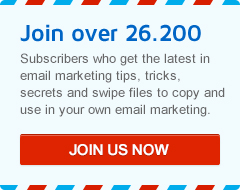7 Insights on Effective Email Marketing Design
Emails can include a variety of content.
We can make them beautiful with images, animations, dynamic copy and buttons. But beauty is only skin deep. We need results. Poor email design can muddy your offer, fail to give readers a clear call-to-action, and put a cap on results. Let’s make your emails more effective by focusing your message and tweaking your design.
7 Insights on how to effectively design marketing emails
Insight #1. Set a single goal
Creating an email before setting the goal is like buying a shirt without checking the size. There is a good chance it won’t fit. This is also true if you’re choosing a template from an ESP. You always need to understand the goal of your email before you design it.
Emails rarely sell a product, generate a download, or achieve any other campaign-level goal. Emails sell clicks. The landing page is where readers make a final conversion. The job of the email is to get them there. So ask yourself, is your email supposed to:
- Bring readers to a product landing page
- Attract site traffic to your blog
- Capture a customer’s order information
- Bring readers to a registration page for your webinar
Keep these goals in mind as we go through the other insights.
Insight #2 – Give your emails a priority
Your email should have a clear hierarchy of information. Anything that does not support the main goal should be eliminated or deemphasised — even if it ruffles a few feathers. Everybody wants all of the information to be the most important, and nobody wishes to admit that their piece of content is not as important as others. If everything is screaming at you, you are not going to be able to hear anything.
Insight #3 – All Offers are not created equal
The goal of your email should be embodied in a clear call-to-action. It should be very obvious what you want readers to do. Do not confuse readers by giving equal emphasis to different calls-to-action, buttons or links. The only exception might be when your goal is to generate traffic to your website with an email newsletter. If your goal is get downloads for your white paper, then have one and only call-to-action. If your goal is to drive traffic in general, you could have several calls-to-action. That way you are going to appeal to a broader audience. Even then, you should test emphasising the strongest piece of content over the others.
Insight #4 – Connect subject lines with previews
Many email browsers provide a small window to preview the top portion of an email before opening it.
If readers find your subject line somewhat interesting, then they will look to the preview pane to persuade them. This makes the top of your email prime real estate. A common mistake is to waste this space on generic information, such as a link to view the email in a Web browser. Instead, feature content in this area that directly relates to the subject line, such as an image of a product being offered. If it’s not a clickable item, or it’s not giving more information about the subject line, then [readers] are going to be more likely to abandon and not engage with you.
Insight #5 – Images need a purpose
A debate on the size and number of images to include in an email has gone on for years. The question does not have one answer for every possible product or service. It varies by industry, and it has more to do with your audience’s preferences than hard-and-fast rules. Many companies include images in their emails.
Here are a few tips on how to use them effectively. Images can communicate much faster than words, but without a specific purpose, images are just filler. If you’re sending a newsletter, for example, they might not be necessary. You can test moving them to the right side of the email, out of the reader’s eye-path, or test eliminating them.
Images can be very valuable, though, when you’re selling to consumers. Sometimes the only way you can explain a Snuggie is to show one. Images do not always load! Several popular email browsers do not load images automatically. Readers have to click to agree to view them, which places a barrier between readers and the rest of your content. You can assume that a portion of your audience will not see your images.
By using well-placed text, alt-tags and other design techniques, you can design an email that will clearly communicate even when its images are turned off.
Insight #6 – Incorporate your website’s design
As prospects engage with you over time, they become familiar with the aesthetics of your brand. They know what to expect when they see your logo, colors and messaging. This is why your emails must be consistent with your brand and your website’s design.
Most people, before they engage with a message, they want to see who it is from. They actually see the graphics first. They recognise the colours and the branding before they read it. Incorporating elements of our website’s design can give readers a subtle reminder of the relationship they have with you, and it can prevent deliverability troubles. Readers will be less likely to mark a message as “spam” if they quickly recognise the sender.
Branding should be consistent between your website and all of your emails, even your transactional emails, Murphy says. Readers need to be reminded that they are dealing with a familiar company.
Insight #7 – Give your tests meaning
There are foundational “principles” and design “conventions” in email, but “best practices” change over time.
The best way to know whether your call-to-action should be a green button or a blue hyperlink is to test it. Despite the great results it can provide, only 42% of email marketers regularly test their emails, and many of them only test subject lines, according to the MarketingSherpa 2013 Email Marketing Benchmark Report. Isolate what you test as there are potentially hundreds of variables you could test in an email — everything from the shape of a button, to the location of an image. When you test too many variables at once, you can never be certain which caused the change in results. This means you cannot safely use the test to inform your designs.
Limit the scope of tests to a specific set of variables. That way you can more clearly identify which variables caused a change in results. Focus a test in one of three main categories of design variables:
- Graphic design – such as the layout
- Branding – such as the colours and fonts
- User-interface – such as the buttons and links
For example, testing a new style of links throughout your email can cause a significant change in results and make it safe to assume that the new links were responsible for the results. If you changed the style and position of the links, who is to say which factor caused the change?
Let’s get started today and put these into practice!
Take a trial with Australia’s leading email marketing service today…








